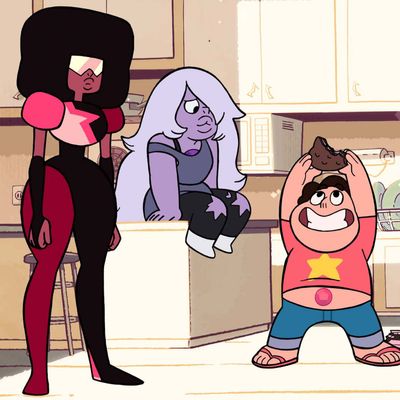
In one simple scene earlier this season, Steven Universe finally confirmed what many queer viewers have long suspected to be true: This is a show with people like us in it. The season-four episode “Last One Out of Beach City” takes place at a rock concert, where a character named Pearl meets a butch rocker with long pink hair and a lip ring. They hit it off, the girl gives Pearl her phone number, and just like that, the mysterious pink-haired girl is revealed as the show’s first explicitly queer human character.
Up until that point, the show dealt mostly in the realm of a playful subtext: What appeared to be a same-sex relationship could be passed off as something that transcended gender and sexuality. Pearl’s burgeoning relationship with this girl proves that Steven Universe — which returns to Cartoon Network with new episodes on January 30 — isn’t just trafficking in clever innuendo. It’s queer. On almost any other mainstream cartoon, the introduction of a bona fide queer character would be considered a groundbreaking moment. On Steven Universe, though, the entrance of this pink-haired girl was so fluid, so casual, and so appropriate that the most exciting thing about her appearance was that it isn’t surprising at all. It was simply another remarkable milestone for what many have long viewed as the queerest animated series on television.
What’s radical about Steven Universe, the brainchild of Adventure Time alum Rebecca Sugar, is not that it shatters gender boundaries. It glides over them as if they didn’t exist in the first place. The premise of the series goes a little something like this: Pearl, Amethyst, and their friend Garnet are genderless alien creatures known as Crystal Gems, who take the form of human women to help raise the show’s titular protagonist, Steven, a half-Gem, half-human teenager.
Steven is a sensitive, chubby kid who quietly redefines gender expectations for boys. He’s not afraid to wear a dress or cry. Moreover, his powers are defensive rather than offensive: He floats when he’s happy, he uses a pink shield, and his magical spit can heal injuries. His character is a stark departure from the archetype of animated male superheroes, whose powers are typically rooted in violence and aggression. Goku from Dragon Ball Z immediately comes to mind, but you can really take your pick: Superman, Naruto, and even Finn from Adventure Time fit the bill. Meanwhile, healing powers have historically been assigned to female characters like Katara in Avatar: The Last Airbender and Aerith in Final Fantasy VII. Most crucially, Steven’s feminine nature isn’t a source of conflict. There’s no point in the show where he’s mocked for embracing femininity, nor does he worry about people ostracizing him. He just is who he is. In the second season episode “Sadie’s Song,” Steven wears makeup, a dress, and heels to perform a pop song to the delight of Beach City’s residents. It’s the show’s way of celebrating Steven for being comfortable enough to celebrate himself.
In this way, Steven also bucks the trend of sissy villains in cartoons and children’s programming, where the big bad is coded as an effeminate gay man. Take the villain of The Powerpuff Girls, HIM, a fabulous lobster devil who wears knee-high boots, pink tulle, and makeup. HIM speaks with a sibilant voice and upward inflections, and he shares the swishy, extravagant mannerisms of other queer-coded male villains with a penchant for mascara, like Jafar from Aladdin, Scar from The Lion King, and Prince John from Robin Hood. This is what truly sets Steven apart: Where his feminine mannerisms would relegate him as either a villain or a punch line on any other show, he’s the hero in Steven Universe, full stop. He’s not strong in spite of his femininity, but because of it.
And make no mistake: Steven Universe’s embrace of queerness is deeply important to fans. In the show, characters can “fuse” by dancing together, combining their bodies to create an entirely new character. A fusion dance between two characters is often intimate, and coded as romantic. One particular dance between Pearl and Steven’s mom in the second-season episode “We Need to Talk” was censored in the United Kingdom because of its lesbian subtext, a move that launched a fan petition in response. Fans pointed out a double standard: The same episode also featured heterosexual dancing and kissing, which is consistent with the British Board of Film Classification’s criteria for “universal” content. The top comment on the petition makes a full-throated defense of the show: “I didn’t feel comfortable coming out as bisexual until I was 30 years old, and a big reason I waited for so long was because I spent my entire childhood in a world where representation of anything other than heteronormative didn’t exist. Steven Universe gave me the courage to embrace who I really am and it’s the type of media I wish I had access to growing up. Queer kids deserve representation.”
Creator Rebecca Sugar, who came out as bisexual last year, has used the freedom afforded by animation to create a world that rejects queer tragedy in favor of queer joy. It’s a world close enough to our own that we can see ourselves in it, but the lack of prejudice and taboo in this universe also makes it a fantasy of sorts. Steven Universe imagines a world where same-sex relationships are common, where the hero can be a male femme, and where a nonbinary character isn’t expected to commit to a gender. We learn as much in the early first-season episode “Alone Together,” in which Steven fuses with Connie, a human girl. When they dance together, they instantaneously become Stevonnie, an androgynous fusion of boy and girl.
In what queer viewers might recognize as a coming-out moment, Stevonnie giddily rushes home to show Pearl, Amethyst, and Garnet their new form. Pearl is shocked: “This is unprecedented. A gem fusing with a human? It’s impossible! Or at the very least inappropriate.” Her discomfort is clear, and she asks them to un-fuse immediately. “You two look great together!” Amethyst says. “How does it feel, Steven? Connie? Stevonnie?” But the best reaction comes from Garnet, who lovingly puts a hand to their cheek. “Stevonnie, you are not two people, and you are not one person,” she says. “You are an experience.”


